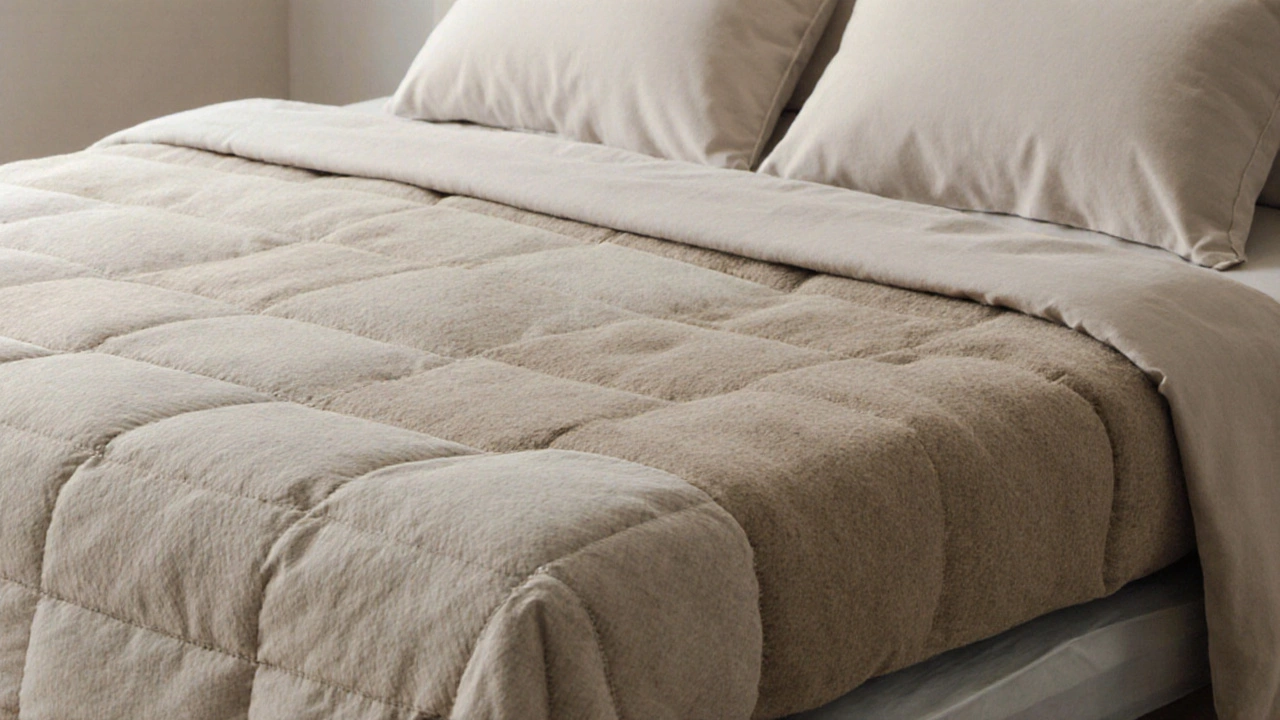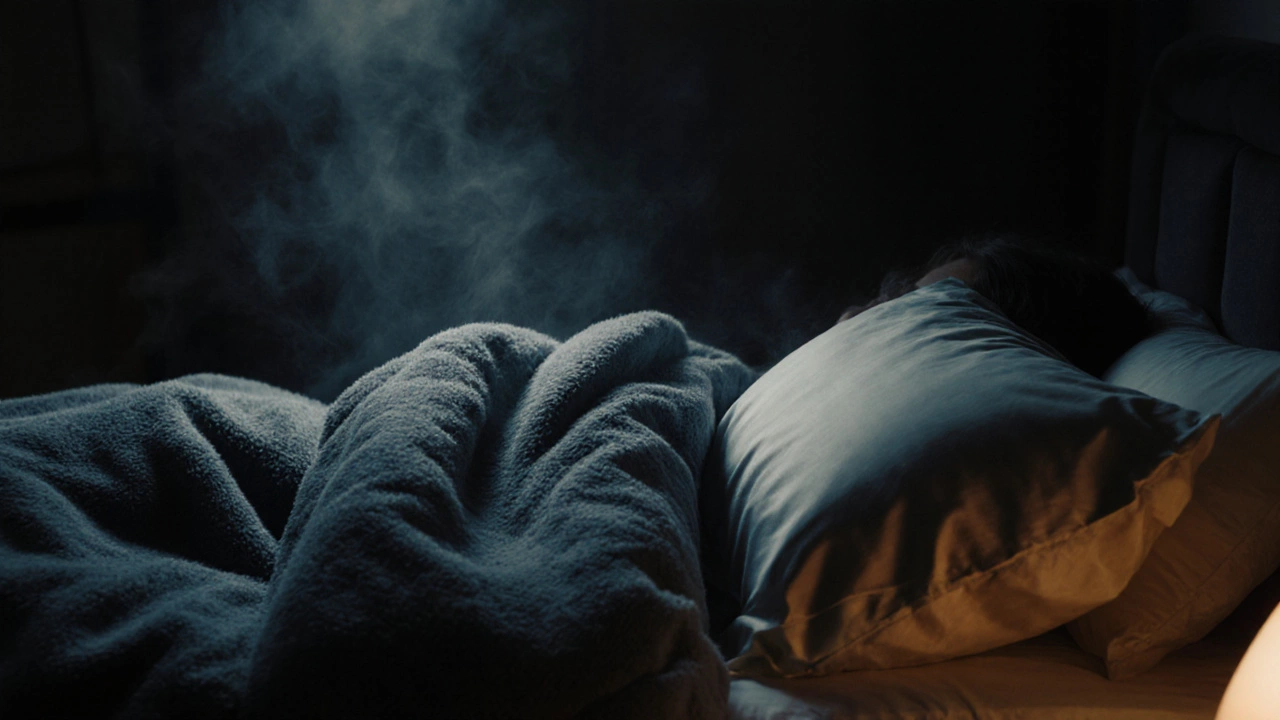Bedding Temperature Regulator Calculator
Your Optimal Bedding
Why this works: Your bedding is optimized for comfort based on clinical sleep science. Cotton percale regulates temperature better than synthetic fabrics, while the correct tog rating prevents overheating.
When you think of bedding, you might picture soft sheets, a fluffy duvet, or a pile of pillows. But what does bedding actually mean? It’s not just what you sleep on-it’s the entire system designed to make your bed comfortable, clean, and inviting. Bedding includes everything you put on or around your mattress to support rest, regulate temperature, and add personal style. It’s the foundation of a good night’s sleep, and understanding its purpose changes how you choose it.
Bedding Isn’t Just Sheets and Pillows
Many people use the word "bedding" to mean just their sheets or comforter. But that’s only part of the story. True bedding is a layered system: fitted sheet, flat sheet, pillowcases, duvet or comforter, bed skirt, and sometimes mattress toppers or protectors. Each piece has a job. The fitted sheet holds everything in place. The flat sheet acts as a barrier between you and the duvet, making it easier to wash and reducing wear. Pillowcases protect your pillows and keep them clean. The duvet traps warmth without adding bulk. Together, they form a functional unit that’s more than the sum of its parts.
In the UK, where winters are damp and summers can turn surprisingly warm, bedding choices matter more than you might think. A cotton percale sheet might feel crisp and cool in July, but in January, you’ll want a flannel top sheet and a wool-filled duvet. Bedding adapts to your climate, your body, and your sleep habits. It’s not decorative-it’s practical.
The Science Behind Comfort
Good bedding doesn’t just feel nice-it helps you sleep better. Studies from the Sleep Council show that people who change their sheets weekly report better sleep quality than those who don’t. Why? Sweat, skin cells, and oils build up over time, creating a microclimate that’s too hot and humid for deep sleep. Breathable fabrics like cotton, linen, and TENCEL™ help wick moisture away, keeping your skin dry and your body at the ideal temperature: around 18°C.
Thread count is often marketed as a sign of quality, but it’s misleading. A 300-thread-count cotton sheet made from long-staple fibers will outperform a 600-thread-count sheet made from short, cheap fibers. The real measure is fiber quality and weave. Percale weaves are cool and crisp; sateen weaves are smooth and slightly warmer. If you’re a hot sleeper, go for percale. If you get chilly at night, sateen or flannel might be better.
And don’t forget the mattress protector. It’s not optional. Even if your mattress is expensive, sweat, spills, and dust mites can damage it over time. A waterproof, breathable protector adds years to your mattress’s life-and keeps your bedding cleaner longer.

Why Bedding Affects Your Mental Health
There’s a reason your mood lifts when you crawl into a freshly made bed. The texture, scent, and feel of clean bedding trigger a psychological response. Soft, clean fabrics signal safety and comfort to your brain. This is why hotels use high-thread-count linens and fresh lavender sprays-they’re not just being fancy. They’re tapping into sleep science.
People with anxiety or depression often report improved sleep when they invest in quality bedding. It’s not magic-it’s sensory regulation. Your bed becomes a calm space, separate from the stress of the day. The ritual of making your bed in the morning also creates a sense of control and order, which research from Yale links to lower stress levels.
Even small changes help. Swapping out synthetic pillowcases for silk or satin reduces friction on your skin and hair, which can ease morning stiffness and prevent breakage. If you’re sensitive to smells, avoid heavily scented detergents. Fragrances can trigger headaches or disrupt sleep in people with sensory sensitivities.
Choosing Bedding That Works for You
There’s no one-size-fits-all bedding. Your ideal setup depends on your body, your climate, and your habits.
- If you sweat at night: Choose cotton, linen, or bamboo. Avoid polyester blends.
- If you’re cold: Layer with a wool or down duvet. Add a flannel top sheet.
- If you have allergies: Use hypoallergenic pillowcases and wash bedding weekly at 60°C.
- If you share a bed: Consider two single duvets. No more tug-of-war over the covers.
- If you like to sleep cool: Skip the mattress topper unless it’s gel-infused.
Don’t buy bedding based on trends. A velvet duvet cover might look luxurious, but it traps heat and isn’t breathable. A 100% cotton set from a reputable brand will serve you better for years.

How Often Should You Replace Bedding?
Sheets and pillowcases should be replaced every 1-2 years, even if they don’t look worn. Over time, fibers break down, and the fabric loses its ability to breathe. Duvets and pillows last longer-5-7 years-but if they’ve lost their shape, smell musty, or you wake up with neck pain, it’s time.
Washing matters too. Wash sheets weekly. Use mild detergent. Skip fabric softener-it coats fibers and reduces absorbency. Dry on low heat or air-dry to extend lifespan. Sunlight naturally kills dust mites, so hang sheets outside when you can.
Bedding Is a Daily Investment
Think of bedding as part of your health routine, like brushing your teeth or drinking water. You wouldn’t skip brushing your teeth because "they still look clean." Same with sheets. They’re not just for show. They’re your first line of defense against poor sleep, skin irritation, and allergens.
Good bedding doesn’t have to be expensive. You can find quality cotton sets for under £30 in UK discount stores or online. What matters is material, weave, and care-not brand names. Focus on what your body tells you. If you wake up sweaty, it’s too hot. If you’re shivering, it’s too thin. Adjust until it feels right.
Your bed is where you spend a third of your life. It deserves more than a quick buy from a supermarket aisle. Take time to understand what bedding really means-not just what it is, but what it does for you.
What is the main purpose of bedding?
The main purpose of bedding is to create a clean, comfortable, and temperature-regulated sleeping environment. It protects your mattress, supports restful sleep by managing moisture and heat, and reduces exposure to allergens and bacteria. Bedding also adds personal comfort and style to your bedroom.
Is bedding the same as sheets?
No, bedding includes sheets but goes beyond them. Bedding refers to the entire set of items used on a bed: fitted sheet, flat sheet, pillowcases, duvet or comforter, mattress protector, and sometimes a bed skirt or topper. Sheets are just one part of the system.
What bedding is best for hot sleepers?
Hot sleepers should choose breathable, natural fabrics like cotton percale, linen, or TENCEL™. Avoid synthetic blends like polyester. Opt for lighter-weight duvets (1.5-4.5 tog) and skip mattress toppers unless they’re gel-infused. Wash sheets weekly and air them out when possible.
How often should I wash my bedding?
Wash sheets and pillowcases every week. Duvets and comforters can go every 2-4 weeks, depending on use. Wash at 60°C if you have allergies to kill dust mites. Use mild detergent and avoid fabric softener, which reduces breathability.
Do I need a mattress protector?
Yes. A mattress protector shields your mattress from sweat, spills, and dust mites. Even if your mattress is expensive, without protection, it can degrade faster and become a breeding ground for allergens. Choose one that’s breathable and waterproof for best results.
Can bedding affect my skin and hair?
Yes. Cotton and linen are gentle on skin and reduce friction. Silk or satin pillowcases can help prevent hair breakage and reduce facial wrinkles caused by pressing into cotton. Synthetic fabrics can trap moisture, leading to acne or irritation, especially for sensitive skin.

